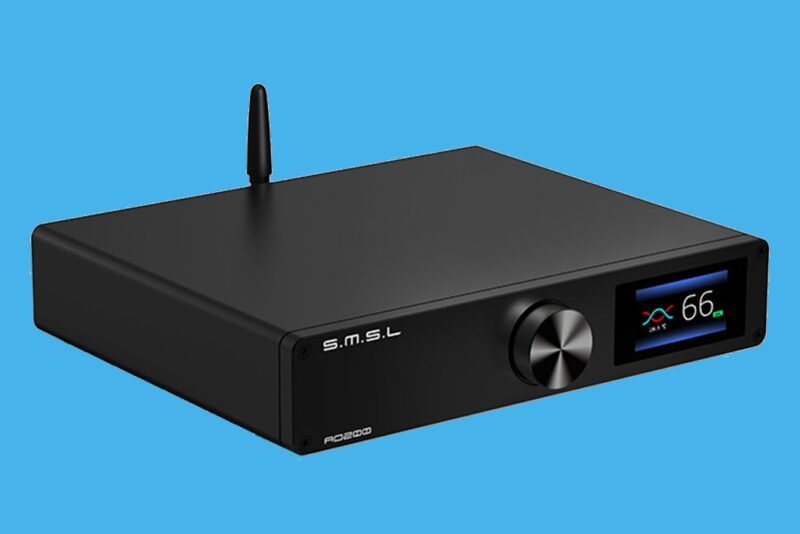TL;DR
As long as you measure your expectations, the eminently affordable S.M.S.L AO200 is an enjoyable Class-D amplifier that gives you just enough detail and imaging to bring life to your music. Pick up a pair of decent bookshelf speakers, and you will have an enchanting system for a small apartment or bedroom.
Overview
If you want a compact and inexpensive stereo amplifier to play some music in a small living room or bedroom, there’s no lack of choices on the internet, especially if you look on Amazon. Finding one that sounds decent is another matter.
The product I’m looking at today, the $279 S.M.S.L AO200 Digital Power Amplifier, is a class D amp that promises 2 x 50W into 8 ohms (and almost double that into 4 ohms) with pretty low distortion. It also has many useful features like a USB input, Remote Control, plus Bluetooth 5.0 for quick and effortless streaming.
So is it worth building a budget hi-fi system around? Well, in a word, yes. Just as long as you don’t have unrealistic expectations of what an under-$300 integrated amp should sound like.
Disclaimer: The S.M.S.L AO200 Digital Power Amplifier was sent to us by Aoshida HiFi in exchange for an honest and impartial review. Thanks to them for the opportunity!
Specs
| Product Model | S.M.S.L AO200 |
| Inputs | XLR, RCA, BT, USB |
| THD+N | 0.003% |
| SNR | 110dB |
| Channel Separation | 98dB |
| Input Sensitivity/Impedance | 280mV/47kΩ |
| Standby Power | 0.5W |
| Size | 187.5×40×154mm(W×H×D) |
| Weight | 0.96kg |
| Package Weight | 1.46kg |
| Output Power | 150W × 150W (2Ω), 90W × 90W (4Ω), 50W × 50W (8Ω) |
| Accessories | S.M.S.L AO200, AC cable, Paper manual, Infrared remote control |
Build/Features
I just reviewed the S.M.S.L HO200 Headphone Amplifier, the sister unit to the AO200 I’m looking at today. Used together, the HO200 can be utilized as a basic pre-amp for the AO200, sending any analog signal fed through it over to the amplifier, which then outputs the signal to a pair of speakers.
Like the HO200, the AO200 Power Amp has a basic but sturdy build which I like. Both the casing and the front/rear panels are made of thick CNC milled aluminum.
Also, like the HO200, the AO200 comes only in a matte black finish, which to me, gives it a serious hi-fi look. It’s about seven and a half inches wide, an inch and a half tall, and six inches deep, which is a little smaller than a hardcover novel.

The compact size makes it perfect for a bedroom or living room system, but at the same time it has enough power to drive even some of the most inefficient bookshelf speakers.
In the box, along with the amp, you get a detachable (read: upgradable) power cord, a manual and a universal remote control made to operate various SMSL products. To use it with the AO200, you have to press the “A” button for Amp before it works.
Setup is pretty simple, all you have to do is plug it in, hook up a set of speakers, possibly a source like a laptop or a streamer, and you’re ready to listen. If you’re going to use the internal Bluetooth receiver, you don’t even need to plug in a source; you can just stream music from a cell phone or tablet.
The AO200 has Bluetooth version 5.0, so connections are quick and stable, but it only has the standard SBC audio codec, so that will limit sound quality somewhat.
On the rear panel, there’s a single set of five-way binding posts for connecting speakers. I used a pair of AudioQuest Rocket speaker cables with pre-installed banana plugs with it, which made speaker connection quick and easy.

To connect a source, you have two analog inputs, one balanced XLR and one single-ended RCA, plus there’s a single USB connection for digital audio input.
Curiously, the DAC chip used for the digital connection is not specified, and neither is the maximum bit depth/sample rate, despite the “Hi-Res Audio” label placed on top of the unit (and the box). I assume this input is PCM only.
I’m not a hundred percent sure you need a balanced XLR connection on a power amp at this price point. I would much rather see an additional digital input, preferably coaxial, but optical would be fine. There are cheaper units on the market that have this, so I know it’s possible.
As it is, the XLR input will let you achieve a balanced connection between the AO200 and the previously mentioned HO200 headphone amp. However, if you have such a setup on your desk, do you need a balanced XLR cable to connect two pieces of gear most likely sitting right on top of each other?
I don’t know if I would bother, but I know somebody out there is looking for such a setup.

On the front of the AO200 is a multi-function wheel that controls power, volume and menu selection along with a small multi-color LCD screen to show you what you’re doing on the unit.
The screen is nice and bright and easy to read provided you are close enough, plus the wheel also works nicely, responding quickly to turns and presses. You can also control the amp with the included remote, which can do everything the button on the front panel does.
Pretty much everything you have to do on the AO200 must be accessed via the menu, which you bring up via a quick press of the button.
In the menu, there are some nice options like Preset EQ, Bass/Treble tone control, screen brightness level, “soft clipping” to avoid distortion during clipping, and a screen timer which turns the screen off after so many seconds.
Input selection is also contained within the menu, which is a little awkward, but you can bypass this by pressing the dedicated input button on the remote, which I suppose one would do most of the time.
Listening To The S.M.S.L AO200 Digital Power Amplifier
I started my listening tests by connecting the AO200 to a pair of €1.800,00 (about $2000 U.S.) Buchardt Audio S400 speakers I was using for a previous review, then connecting my Samsung Galaxy S21 Ultra 5G to the AO200 via Bluetooth.
I know that may sound crazy, but there was a method to my madness. First of all, I wanted to see how the AO200 would work with a relatively hard to drive set of speakers (the S400 has 88db sensitivity), plus I wanted to hear the quality of the Bluetooth connection.
Since the AO200 was only compatible with the standard SBC audio codec, I didn’t expect much due to the low bitrate transfer, but surprisingly the amp was able to make those relatively expensive speakers sing. Not only that, it actually didn’t sound horrible.
First of all, I was surprised to hear that the AO200 could drive the Buchardt Audio S400 with finesse and control. This was something several amps many times the price of the AO200 haven’t been able to do. The Infineon MA12070 amp chips do their job well, and having one per channel gives this amp headroom not achievable by competitors that only use one of these chips for both channels.

I also loved the tonal balance, as it didn’t try to play up any part of the music, it just let the speaker do their thing for the most part. If anything there was a slight bump in the lower bass that added some welcome weight to the performance.
That weight made the music sound bigger than what you would expect from a tiny Class-D amp. Most people hear Class-D amp, and immediately think the sound will be thin and metallic. This amp sounded more natural and organic.
When listening to one of my favorite testing albums, “Unplugged” by Eric Clapton, I also heard the openness this amp was capable of. The S400s have an amazing soundstage and the AO200 was able to fill this space and image capably.
I was able to hear Clapton’s vocal and guitar off to the right, and the background vocalist off to the left, and it was done with a sweetness that really drew me in. It was a very musical sound. Overall, this amp has a pretty clean performance, especially for one that retails under $300.

Next I connected my HP Envy X360 laptop to the AO200’s USB input using an AudioQuest Forest USB cable, and played the same album via the Tidal desktop app. Through the wired connection, I was able to hear just a bit more detail and focus in the imaging compared to the Bluetooth connection.
I also connected the $399 ZEN Stream Network Streamer to the unbalanced input using a pair of AudioQuest Evergreen RCA interconnects, and it provided just a little bit more detail and depth than the USB connection, but not much.
That said, with the AO200 I did miss some of the depth, separation, and layering i’ve heard with the S400 using more expensive amps like the Audiolab 6000A or Cambridge Audio CXA81. But I kinda expected that due to the fact they cost several times more.
However, I thought the AO200 had better control over the S400’s low end than the 6000A, giving it more scale and weight, which is impressive.
I also tried some budget bookshelf speakers with the AO200 so I could make some affordable system recommendations. My two favorites were the $469 Q Acoustics 3030i, which I recommend for those who like a more refined mid-centric sound, and the $299 KLH Albany II for those who want a smaller, more affordable speaker that still manages to sound big and exciting.
The Wrap Up
While I wish it had better specs when it comes to Bluetooth codecs and physical connections, at the end of the day the AO200 has the goods where it counts. That would be sound quality and output power. If you want a capable amp that can form the heart of a budget hi-fi for your apartment or large bedroom, you should check the SMSL AO200 Digital Power Amplifier out.
Hifitrends is reader-supported. When you purchase through links on our site, we may earn an affiliate commission. Prices are subject to change at any time.

I’m an audio writer who started as a young audio salesman/consumer electronics professional back in the late 90s. That’s where I discovered the magic of 2-Channel sound. My hunger for great sound has led me on a delightful music quest that continues today.



Leave a Reply